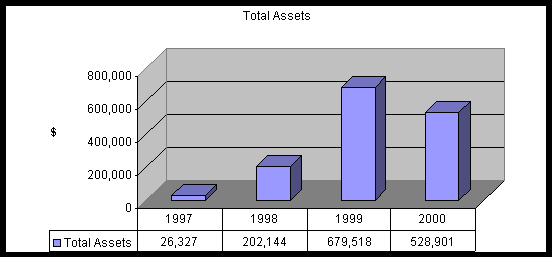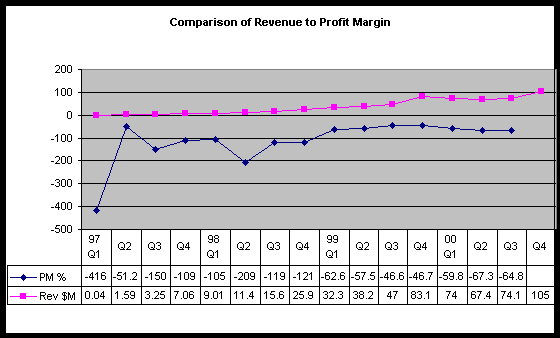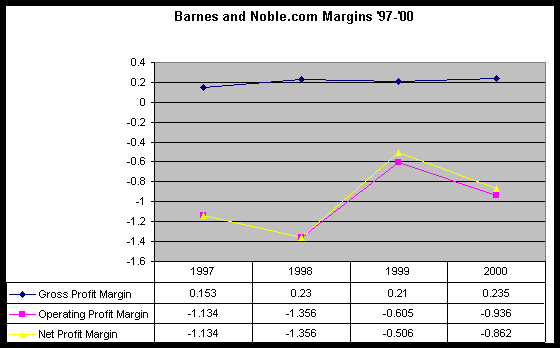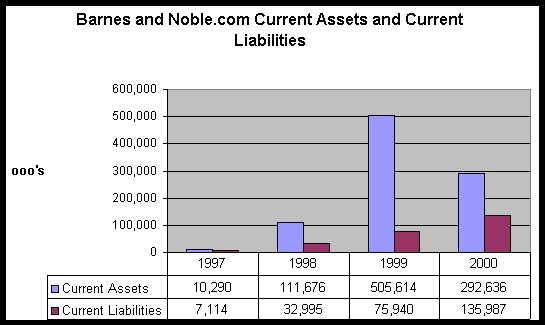
Background
Barnes and Noble.com (B&N.com) is an Internet commerce company, focused on the sale of a broad range of knowledge, information, education and entertainment related products. Itís the first online bookseller to offer a vast in-stock inventory with an editorially rich book-selling environment. Since launching its online business in May 1997, it has become one of the worldís largest web sites. They offer a variety of shopping sources to make purchases more convenient. These include product search capabilities, book and music reviews, author biographies, book summaries, gift-wrapping and gift registries. B&N.com offer sameday delivery in the Manhattan are and thereís also an ability to return merchandise to Barnes and Noble bookstores. It stocks the largest in-stock selection of in-print book titles, supplemented by more than 16 million items available for sale in out of print, rare and used book dealers. Even though they have extended sales into music, software, magazines and posters, itís their online book selling that generates their revenue. For 1999, 1998, and 1997, online book selling generated approximately 93%, 98% and 100% respectively of B&N.comís total revenue.
Another important issue is B&N.comís acquisition of Fatbrain.com, who operate a web site that sells professional, academic and technical books. It operates web sites specifically for corporate intranets where company employees can purchase books or technical manuals. Fatbrain.com provides services for cataloguing, distributing or managing company documents in digital formats.
Industrial Analysis
In analysing companies such as Amazon.com and Barnes and Noble.com it is necessary to look at the industry in which they partake. It has suggested that itís the following five forces that influence the average profitability within a particular industry.
Rivalry among existing firms
The e-commerce market as well as the retail book-selling business is highly competitive. Since the introduction of e-commerce to the Internet, the number of e-commerce web sites competing for customer attention has increased rapidly. The two main players within the industry are Barnes and Noble.com and Amazon.com. Major rivalry exists between the two companies. For example, in September 2000, Yahoo! Inc. announced that it had mad B&N.com a featured merchant on its site, effectively replacing Amazon.com. This wide-ranging deal gave B&N.com premium placement on several Yahoo! Pages, such as Yahoo! Amazon.com has a longer online operating history and a longer existing customer base than B&N.com. These major players also compete with retail web sites such as Buy.com and Borders.com for book and music sales. With respect to the sale of music, software and videos, they compete with numerous merchants including other Internet based companies such as Cd-now, Real.com and Beyond.com. Itís also acknowledged that other online retailers, and direct competition to Amazon.com and B&N.com, are offering substantial discounts on products- including books, music CDís, DVDís etc, which are subsidised by advertising revenue from their web sites. An increase in this type of activity could lead to additional pricing pressures on the two main companies. Both of these plan to continue expanding their product ranges and will face intense competition for those products also. Take for example the software sector in which the competition includes Egghead.com and Beyond.com. The nature of the Internet as an e-marketplace may make this industry more competitive than traditional retailers due to the increased ability for comparison-shopping. This increased competitiveness among online retailers may result in reducing operating margins, loss of market share and a diminishing brand franchise.
Threat of new entrants
It is expected in the future that competition in this are will intensify given the relative ease with which new web sites can be developed. Itís understood that the primary competitive factors in this area are brand recognition, price, cost, site content, ease of use, speed, fulfilment, customer support, reliability and availability of products. The success of online retailing companies will depend on their ability to provide a compelling and satisfying shopping experience. With the ease of entry itís important that such companies like Amazon.com and B&N.com sustain a high quality service thus maintaining their advantage in the area. These of course have first mover advantage over potential entrants and therefore have built up a certain amount of brand loyalty. Another threat, which may develop due to new entrants, is the competition for appropriately skilled workers. Will the large companies continue their ability to attract experienced marketing, technology, operations and management talent?
Old fashion retailers may have to look to online selling if they want to stay in touch. This industry is particularly suited to e-commerce because an online store has virtually unlimited shelf space and has the ability to offer customers anywhere the user-friendly experience of browsing through vast product information databases. As technology continues to develop and improvements are made to search engines, ease of access will grow and customers will rely on this type of shopping experience.
Threat of substitute products
Both Amazon.com and B&N.COM have virtually ruled out this particular element because of their willingness to expand their product ranges. Book sales are the primary sales for both companies but substitute products are being made available also. Substitute products include videos, DVDís, music CDís, software and posters, all of which are now being sold on their web sites. It is necessary that little substitute products exist because this will be focusing customerís attention outside of the companyís web sites. This is a prime reason for both companies expansion into different entertainment products.
Bargaining power of buyers
Being an Internet based industry where comparing prices is at the click of a button there is high price sensitivity. The switching costs are low and this leaves the buyers in a strong position. The web-based retailing industry is one of the highest price sensitive markets around. The high competition and battle for market share gives the buyer the option of checking the best available price.
Bargaining power of sellers
Suppliers are relatively powerful within the industry. Suppliers in the industry will be powerful if they can supply in a timely and efficient manner and agree on reasonably acceptable terms. B&N.com rely on the Barnes & Noble distribution centre and various book wholesalers like Ingram, Baker & Taylor and Bookzine. They rely on these to quickly obtain about 900,000 different titles, the majority being from the B&N distribution centre. These companies depend on book sales for the majority of their revenue, thus suppliers have bargaining power especially if they are reliable and efficient.
Strategy Analysis for B&N.com
B&N.com has pursued a strategy of concentrating on the sale of a wide variety of knowledge, information, education and entertainment type products. Because of the intense competition within the industry B&N.com intend to provide the highest level of service. Thus, they want to improve ease of access to the site, the speed of delivery to the customer and the variety of products available. Opportunities to expand are sought therefore providing extra products for their customers. This is a major strategic plan for B&N.com and to achieve it their operating strategy is focused on rapidly expanding its brand and increasing its customer and revenue base. The following are particular areas within B&N.comís strategy:
B&N.com want to continue to invest in technology to support future growth. They want to acquire the equipment that will allow them to conduct personalised one-to-one marketing
They believe that itís necessary to have a wide range of products available to customers. To further this, a quick delivery system may lead to a major competitive advantage over their competitors.
This strategy will benefit B&N.com in that it will continue to use this high tech distribution centre as itís primary supplier, leverage their brand name and gain some valuable experience from their management team.
They aspire to increasing user friendliness. Itís necessary in this particular industry that the customers are pleased with the presentation of the web site, so continued work is done to improve the design, layout and navigation within it.
Online, radio, television and print advertising were carefully selected in 199 to try and improve their customer base. They seek to drive down customer acquisition cost and are trying to get customers to visit the site more frequently and improve the size of the average purchase.
6. To gain acquisitions and Strategic relationships
This is the process that B&N.com see as the best method of improvement. These investments in complementary businesses and companies expand their product offerings. By doing this the company can expand itís scope by benefiting from the investments, marketing and technology incentives of industry leaders. Examples of recent strategic relationships include the following:
a) B&N.com acquired up to a 32% stake in enews.com- the largest retailer of magazine subscriptions.
Itís necessary also to take a look at the future strategy prospect of B&N.com. in the short-term they plan to increase their customer base by continuing to jointly market and conduct seasonal and other special promotions with Barnes and Noble Inc. Their integration plans include:
( I ) Internet service counters to be added to more than 600 Barnes and noble stores.
( II ) The introduction of a membership loyalty program, called "Readersí Advantage"
that will offer discounts to both store and web customers.
( III ) A new policy to have Barnes & Noble stores accept returns of online purchases.
B&N.com also plans to continue to add features to their website and to partner with other companies to promote itís business.
They continued the integration of fatbrain.com by reorganising, thus closing one of its original processing centres in New Jersey as well as the Fatbrain.com operation in Kentucky. They have streamlined shifts through the distribution centre network.
The long-term outlook sees B&N.com diversifying itís revenue beyond book sales by continuing to expand into complementary products and services through investments in and partnerships with other companies. They plan to increase the number of Fatbrain.comís corporate customers by increasing their sales force.
What Strategy then is B&N.com using to sustain competitive advantage?
B&N.com use the differentiation policy to try to build and sustain competitive advantage. This involves trying to create the best product for the customers. Aspects such as design, customer service, product quality and product variety become vital. B&N.com try to gain superiority in their market by improving the design of their website, making access easy and creating a user friendly navigational system. They are trying to improve their product variety and reduce the delivery time. Their differentiation strategy can also be seen by their investments, their reliance on brand image and reputation. B&N.com are trying to continue being creative and innovative in an effort to gain extra market share. B&N.com though have high cost implications. I donít think they have acceptable costs for the differentiation. This shows how much they believe in this strategy as a way to go in the future. Being different or unique is a precious advantage but itís the cost implications that are the danger. At the moment though B&N.com seem to have the resources to cope, as they have no debt. Are B&N.com structuring their activities in a way thatís consistent with their strategy?
The answer here is yes, as the marketing expense as a percentage of sales decreased to 22% in 2000, compared with 36% in 1999. Both the growth margin improvement and the decrease in these expenses as a percentage of sales reflect the companyís strategy of curtailing promotional discounting and marketing expenditure.
Accounting Analysis for B&N.com
Advertising is something B&N have worked on recently to try and gain market share. Their advertising expense for the years ended December 31, 1999, 1998, and 1997 was $41,845, $32,435 and $3,100 respectively. B&N.com expense the costs of their advertising for magazine, television, radio and other media the first time the advertising takes place.
A second important area is that of income tax. Before 1 November 1998 B&N.com was included in Barnes and Nobleís U.S. consolidated income tax returns. Thus the benefits incurred due to losses by B&N.com were realised by Barnes and Noble. This was until the operations of the entity were contributed to a limited liability company and as such is not considered income tax equity. Thus no benefits have been given to B&N.com for its losses to date.
Computers and equipment are depreciated using the straight-line method over their estimated useful lives of three to ten years. The leasehold improvements are capitalised over the shorter of their estimated useful lives or the terms of the lease. The Accounting Standards Executive Committee in 1998 issued a statement of position 98-1 " Accounting for the cost of computer software developed or obtained for limited use" ( SOP 98-1 ). This requires that all costs that relate to the development of internally used software be expensed as incurred. Costs incurred during the application development stage must be capitalised and amortised over the estimated useful life of the software. This has been applied within the B&N.com structure.
Sales of B&N.comís products are taken (net of estimated return) at the time the products are shipped to customers.
Coupon redemption are recorded as a reduction on sales, this is in accordance with EITF 00-14. It was formerly classified as a marketing and sales expense.
Quality of disclosure
I believe that B&N.com could give more information on industry conditions or major future plans. In their letter to the shareholders in the 1999 Annual report the emphasis is mainly on their continued success, business initiatives and recent highlights. There is however a good section dealing with some key accounting policies and the notes to their accounts clearly show what they mean. A key aspect of disclosure is they cannot capitalise much of their outlays such as product quality or customer service. The future benefits of these are probably certain yet due to disclosure rules they cannot show any benefit on their books. This is an area where B&N.com spend much time and finance as they use a differentiation method of strategy, which means that they must continue to improve quality and service.
One aspect that I found difficult to gain knowledge on was their acquisition of Fatbrain.com. This was one o their major acquisitions yet not much information existed on them. The share price has been doing very poorly in the last 12 months yet little explanation was forthcoming. Their strategy was clear yet they didnít relate it to their previous bad performance or provide information on whether it should turn around or not.
Financial Analysis
The firmís performance, both past and present, can be analysed through ratio analysis and cash flow analysis. The analysis is carried out based on the financial statements of the two companies. It is important that we focus on both past performance and current status of operations.
Profitability analysis

|
Year |
ROE |
ROA |
|
2000 |
-1.52 |
-.316 |
|
1999 |
-.849 |
-.07 |
|
1998 |
-.4916 |
-.411 |
|
1997 |
-.705 |
-.515 |
The above chart analyses the ROE an ROA performance of B&N.com during the last four years. The ROE is Net income/Shareholders equity and is a good indicator of a firms overall performance. It indicates how funds provided by shareholders are used to generate profit. The ROE for B&N.com is very poor and continues to decrease. Being in the negative area of the chart shows the company are making losses. The net loss has steadily increased from 1997 to 2000, from 13,552 to 167,096. This reflect an incredible 1132% increase in losses since 1997.The upward trend noticed between 1997 and 1998 was due to a large increase in shareholders equity that year. The total assets: shareholders equity ratio was very large in 1999 and 2000 thus driving down ROE. The ROA tells how much the company can generate for each dollar of assets invested. Again there is negative value but an increase can be seen. This is due to the large increase in assets in 1999 and 2000, which can be seen below.

Taking a look at the margins for B&N.com itís clear that it is the operating expenses that are the reason for the large losses. There has been a steady increase in both annual sales and revenue, which is not being realised in profits (see Dig. below).

The gross profit margin is steady at about 20% yet the operating profit margin is deep in the negative values, because of the increase in net loss. Both gross profit and sales have increased steadily in the last four years keeping the gross profit margin consistent. This shows that the firm has an efficient price strategy in the market and have a relatively efficient "production" process. Therefore the company will need to examine their operational expenses and whether or not they are aligned with their strategy. Being a differentiation company these activities are necessary but is this level acceptable in the long run. B&N.com are expanding its product range but are the costs incurred in doing so overriding the advantage they gain from their strategy.

Liquidity Analysis
Itís necessary to look at B&N.comís ability to repay its current liabilities if the need arose.

Taking a creditors perspective, B&N.com seem to be very efficient in term of liquidity. The current ratio and quick ratio, although down on 1998, are above 1.
The quick and cash ratios capture the companyís ability to cover its current liabilities from liquid assets. The main reason for the high peak in 1999 is due to the large increase in current assets to 505,614K. Cash and short-term investments rose significantly during this period also. Thus overall the company is good in terms of quickly generating cash if necessary. The acid test is another liquidity ratio that can be taken. It is unlikely that all creditors may require payment together and thus some companies may not worry about it being below zero. This is something B&N.com need not worry about as they have acid test ratios from 1997-2000 of 1.36, 3.34, 6.6, and 1.79 respectively.
The graph below illustrates the reasons for such positive ratios. Current assets are exceeding current liabilities every year and the peak above can be seen in this bar graph illustration. The chart takes the same shape as the previous liquidity ratio graph.

Stock Market Evaluation
These investor ratios allow shareholders to compare the benefit of the investment with the amount they have paid, or intend to pay, for their shares.
The most common measure here of performance and progress is Earnings Per Share (EPS).

Looking at the Share Price for the past 22 months it is clear the dreadful performance of it. At the beginning large profits were expected thus the high share price. The share price was expected to increase with time. Thus when the expected share price increase did not occur merged with the fact that there was large negative EPS, the value of the shares dropped significantly. This is a reflection on the overall poor performance of B&N.com. The company has no dividends, as it is the law that dividends are paid out of profit, which do not exist. The following graph is a clear illustration of the share price performance over the last 22 months.
Debt Ratios
B&N.com have no short or long-term debt and therefore none of the debt ratios are relevant.
Internal Indicators of performance
Bibliography
Books & Articles:
White,Gerald, et al., "The Analysis and Use of Financial Statements", 2nd Ed.
John Wiley & Sons, Inc.,1997
Coursework, "A Framework for Doing Business Analysis Using Financial Statements"
Roberts, John, "Strategy and Accounting in a U.K. Conglomerate" Accounting Organisation and Society Vol. 15, No Ĺ pp. 107-126, 1990
Simons, Robert, "The role of management control systems in creating competitive advantage: New perspectives"
Accounting Organisation and Society Vol. 15, No Ĺ pp. 127-143, 1990
Web Pages:
www.business.com
http://news.moneycentral.msn.com
www,nasdaq.com
www. Bigchart.com
www.amazon.com
Annual Reports
Barnes and Noble.com Annual Report 1999
Amazon.com Annual Report 1999
Appendix
Other Profitability ratios for B&N.com
|
1997 |
1998 |
1999 |
2000 |
|
|
Net profit to sales |
-1.134 |
-1.345 |
-0.506 |
-0.861 |
|
Total asset usage |
0.454 |
0.034 |
0.298 |
0.605 |
|
Fixed asset usage |
0.745 |
0.6834 |
1.165 |
1.355 |
|
Working capital Turnover |
3.76 |
0.78 |
0.471 |
2.044 |
Other Liquidity ratios for B&N.com
|
Acid Ratio |
1.36 |
3.34 |
6.6 |
1.797 |
|
Debtor days |
13.13 |
14.09 |
27.96 |
29.79 |
|
Rate of usage of stock |
16.45 |
30.126 |
41.16 |
5.43 |
|
operating cash flow |
0 |
2.94 |
3.26 |
1.32 |